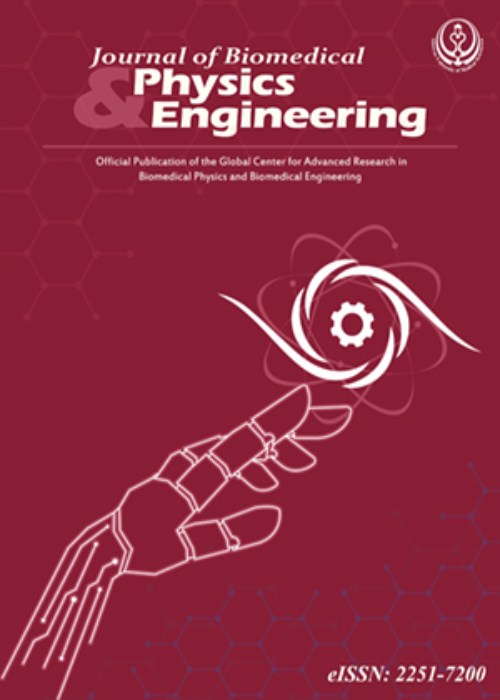فهرست مطالب
Journal of Biomedical Physics & Engineering
Volume:4 Issue: 2, Mar-Apr 2014
- تاریخ انتشار: 1393/03/15
- تعداد عناوین: 5
-
-
Page 43BackgroundThe accurate results of the individual doses in personal dosimety which are reported by the service providers in personal dosimetry are very important. There are national / international criteria for acceptable dosimetry system performance.ObjectiveIn this research, the sources of uncertainties are identified, measured and calculated in a personal dosimetry system by TLD.MethodThese sources are included; inhomogeneity of TLDs sensitivity, variabil- ity of TLD readings due to limited sensitivity and background, energy dependence, directional dependence, non-linearity of the response, fading, dependent on ambient temperature / humidity and calibration errors, which may affect on the dose responses. Some parameters which influence on the above sources of uncertainty are studied for Harshaw TLD-100 cards dosimeters as well as the hot gas Harshaw 6600 TLD reader system.ResultsThe individual uncertainties of each sources was measured less than 6.7% in 68% confidence level. The total uncertainty was calculated 17.5% with 95% confi- dence level.ConclusionThe TLD-100 personal dosimeters as well as the Harshaw TLD-100 reader 6600 system show the total uncertainty value which is less than that of admis- sible value of 42% for personal dosimetry services.
-
Page 49BackgroundNear infrared spectroscopy imaging is one of the new techniques used for investigating structural and functionality of different body tissues. This is done by injecting light into the medium and measuring the photon intensity at the surface of the tissue.MethodIn this paper the different medical applications, various imaging and simulation techniques of NIRS imaging is described. Each method is introduced and discussed. Then, the optimized model is prepared for numerical simulations. In this paper, the finite element method is used for solving the diffusion equation numerically.ResultsDiffusion equation was solved for realistic human head model using finite element approach for a point light source and time resolved case. The photon intensity distribution in different head layers has been shown and the intensity orientation via the CSF layer has been illustrated.ConclusionSimulating the photon transformation inside the tissue is essential for investigating the NIRS imaging technique. The finite element approach is a fast and accurate method for simulating this fact. The time resolved approach of this technique could illustrate the photon migration and intensity orientation in the tissue for time dependent light sources in tissues.
-
Page 61BackgroundA pressure ulcer is a complication related to the need for the care and treatment of primarily disabled and elderly people. With the decrease of the blood flow caused by the pressure loaded, ulcers are formed and the tissue will be wasted with the passage of time.Objectivethe aim of this study was to construct blood flow monitoring system on the heel tissue which was under external pressure in order to evaluate the tissue treatment in the ulcer.MethodsTo measure the blood flow changes, three infrared optical transmitters were used at the distances of 5, 10, and 15 mm to the receiver. Blood flow changes in heels were assessed in pressures 0, 30, and 60 mmHg. The time features were extracted for analysis from the recorded signal by MATLAB software. Changes of the time features under different pressures were evaluated at the three distances by ANOVA in SPSS software. The level of significance was considered at 0.05.ResultsIn this study, 15 subjects, including both male and female, with the mean age of 54±7 participated. The results showed that the signal amplitude, power and absolute signal decreased significantly when pressure on the tissue increased in different layers (p<0.05). Heart rate only decreased significantly in pressures more than 30 mmHg (p=0.02). In pressures more than 30 mmHg, in addition to a decrease in the time features, the pattern of blood flow signal changed and it wasn''t the same as no-load signal.ConclusionsBy detecting the time features, we can reach an early diagnosis to prognosticate the degeneration of the tissue under pressure and it can be recommended as a method to predict bedsores in the heel.
-
Page 69The interaction of radiation with cells and tissues has a random nature. Therefore, understanding the random nature of cell killing that is determined by Poisson distribution statistics is an essential point in education of radiation biology. RadBioStat is a newly developed educational MATLAB-based software designed for computer-assisted learning of the target theory in radiation biology. Although its potential applications is developing rapidly, currently RadBioStat software can be a useful tool in computer-assisted education of radiobiological models such as single target single hit, multiple target single hit and multiple target multiple hit. Scholars'' feedback is valuable to the producers of this software and help them continuously improve this product, add new features and increase its desirability and functionality.


